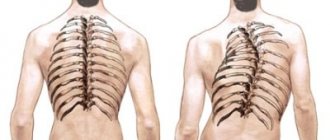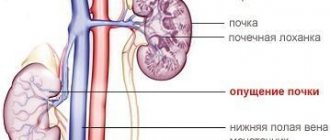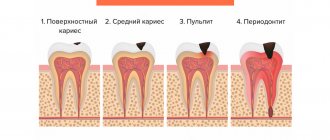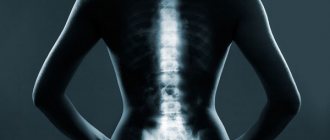Make an appointment by phone: +7 (343) 355-56-57
+7
- About the disease
- How to cure
- Prices
- Sign up
- Specialists
- About the disease
- Prices
- Sign up
Spinal diseases affect 70% of the world's population. Pain reduces social activity and leads to temporary disability. The process can occur in different parts of the spine. Often the cause of ailments is destruction of the lower back, which characterizes lumbosacral radiculitis.
Causes
- degenerative changes: osteochondrosis (protrusion, disc herniation), spondyloarthrosis, vertebral displacement (spondylolisthesis, spondylolysis)
- vertebral compression fractures due to osteoporosis or trauma
- problems with posture (scoliosis, kyphosis, lordosis);
- inflammatory process (spondylodiscitis, spondyloarthritis, rheumatoid arthritis, abscess)
- tumors;
The process can be triggered by: physical activity, hypothermia, lifting (carrying) heavy objects, a sedentary lifestyle and excess weight, pregnancy.
Which doctor should I contact?
Neurologists are involved in the diagnosis and treatment of radiculitis; if necessary, other specialized specialists are involved - vertebrologists, orthopedic traumatologists, and neurosurgeons. Complex therapy can be carried out with the participation of a chiropractor, physical therapist and reflexologist.
Symptoms
The main place among the symptoms of lumbosacral radiculitis is pain. Classification by type of pain syndrome:
- 1. Lumbago. This is a reflex spasm of the paravertebral muscles. Characterized by acute pain in the lower back. Often occurs during (after) physical activity.
- 2. Lumboischialgia. This is a reflex spasm of the paravertebral muscles and piriformis muscle (usually on one side) irradiating to the gluteal region.
- 3. Lumbar radiculopathy: pain in the lumbar region with irradiation along the affected radicular nerve, sensory and motor disturbances in the area of nerve intervention. The upper segments 1-3 are the perineum, genitals, 4-5 and 1 cross are the lower limbs. In the chronic course of the disease, sensory and motor impairments may no longer recover, a chronic pain syndrome may form, the most dangerous complication is spinal canal stenosis with pressure on the spinal cord or spinal cord roots (cauda equina). Paresis of the lower extremities and pelvic dysfunction develop. This complication requires an emergency consultation with a neurosurgeon and a solution to the issue of surgical intervention and decompression of the spinal canal.
Radiculitis lumbosacral
12518 June 29
IMPORTANT!
The information in this section cannot be used for self-diagnosis and self-treatment.
In case of pain or other exacerbation of the disease, diagnostic tests should be prescribed only by the attending physician. To make a diagnosis and properly prescribe treatment, you should contact your doctor. Lumbosacral radiculitis: causes of occurrence, what diseases it occurs with, diagnosis and treatment methods.
Definition
Lumbosacral radiculitis, or radiculopathy, is a symptom complex that occurs as a result of pinching and inflammation of the spinal nerve roots in the lumbar and/or sacral spine.
Typically, this condition develops in people over 45, but in recent years, young people have also begun to complain of sciatica.
People whose work involves heavy physical labor or prolonged stay in one position, professional athletes are susceptible to the development of radiculopathy; patients with autoimmune diseases; those who are overweight and/or have metabolic diseases.
Radiculitis is characterized by lower back pain combined with shooting or pulling pain along the side or back of the leg (sometimes down to the foot), numbness and paresthesia, muscle weakness, increased pain when raising a straight leg.
Varieties of radiculitis
Radiculopathy can result from mechanical damage or an infectious process. Damage can develop both in the intervertebral discs and directly in the vertebral body or its processes.
Pain with radiculitis can be sharp (lumbago), shooting or stabbing (sciatica), burning or aching (lumboischialgia).
- Lumbago is an acute pain that appears suddenly as a result of sudden lifting of weights, sneezing, coughing, due to hypothermia of the lower back (for example, under air conditioning) or spasms of the lower back muscles, or intervertebral hernias.
- Sciatica is a shooting or stabbing pain that radiates to the buttocks, thighs, and calf muscles, as a result of which the patient may complain of muscle weakness (“legs can’t hold up”) and even numbness of the limbs.
- Lumboischialgia is a burning or aching pain that is localized in the gluteal muscles and thighs. It is characterized by a gradual increase.
Possible causes of sciatica
- Hernia or protrusion (bulging) of the intervertebral disc.
- Spondylosis is a chronic degenerative lesion of the spine that develops as a result of aging, overload or injury.
- Spinal stenosis.
- Osteophytes are growths of bone tissue that resemble hooks or spines in shape.
- Sacralization or lumbarization of the sacrum.
- Spondyloarthrosis is a chronic disease of the intervertebral joints, manifested by degenerative changes in cartilaginous tissues and leading to a decrease in the height of the intervertebral discs, tightening of the ligaments, and deformation of the intervertebral joints.
- Ankylosing spondylitis (Bechterew's disease).
- Vertebral fractures (including compression fractures due to osteoporosis).
- Hormonal changes that reduce the strength of cartilage and bone tissue.
Which doctors should you contact if you have lower back pain
? If you have signs of radiculitis, you should consult a doctor for examination and clarification of the diagnosis. In the future, he is engaged in the treatment of radiculitis.
Diagnostics and examinations for radiculitis
Before prescribing instrumental examinations, the doctor collects anamnesis and conducts physiological tests to identify symptoms of “tension” - specific signs of pathology of the nerve roots.
To diagnose spinal diseases the following is prescribed:
- X-ray of the lumbosacral spine with functional tests;
Diagnostics
A neurologist diagnoses radiculitis. He carefully analyzes the patient’s complaints, performs palpation of the body along the nerve trunks and a series of neurological tests. A characteristic symptom is Lasegue’s symptom (exacerbation of pain when raising the leg while lying down) and others.
To determine the cause of radiculitis, clarify the location of its occurrence, and distinguish it from other diseases with similar symptoms, the following are prescribed:
- X-ray – to assess the deformation of vertebral structures.
- ECG - to exclude cardiovascular pathologies.
- Electromyography is an assessment of the passage of nerve impulses.
- MRI – assessment of soft and hard structures of the spine, the degree of nerve pinching.
- CT scan – examination of the spine.
- Blood and urine tests.
The list of examinations is prescribed individually for each patient.
Preventive measures:
- active lifestyle, regular sports and swimming;
- avoiding hypothermia and excessive stress;
- correct load distribution when lifting and carrying heavy objects;
- balanced healthy diet;
- proper organization of the workplace, purchasing ergonomic furniture;
- timely seeking help for diseases of the musculoskeletal system.
At the CELT clinic they know how to return you to normal life! If you are tired of enduring pain, contact us!
Make an appointment through the application or by calling +7 +7 We work every day:
- Monday—Friday: 8.00—20.00
- Saturday: 8.00–18.00
- Sunday is a day off
The nearest metro and MCC stations to the clinic:
- Highway of Enthusiasts or Perovo
- Partisan
- Enthusiast Highway
Driving directions
Drug treatment
Non-steroidal anti-inflammatory drugs (NSAIDs) are prescribed to relieve acute pain, inflammation and muscle spasms. These are drugs based on diclofenac, nimesulide, ibuprofen, meloxicam. The choice of dosage form depends on the intensity of the symptoms: severe pain is eliminated with intramuscular injections, moderate pain can be relieved with tablets. In the acute period, local agents - ointments, gels and creams - can additionally be used. The second choice drugs are steroids - Hydrocortisone, Dexamethasone, Diprospan. They have a powerful anti-inflammatory effect. If NSAIDs with hormones are ineffective, then therapeutic blockades with Lidocaine and Novocaine are performed.
Antispasmodics and muscle relaxants (Mydocalm) help relax spasmodic muscles. If swelling is present, diuretics and magnesium sulfate are prescribed. Swollen tissues put additional pressure on the nerve, so removing excess fluid greatly alleviates the condition. To enhance the effect of analgesics and normalize the functioning of the nervous system, sedatives are added. Treatment of lumbar radiculitis also includes B vitamins, which improve nerve conduction. The most commonly used are Milgamma and Neuromultivit. If the disease is of non-infectious origin, then ointments with a warming effect can be prescribed - based on turpentine, snake and bee venoms, camphor. They relieve pain due to local irritant action.
What is the danger of radiculitis?
- In the absence of timely assistance, the disease usually takes a chronic course. Chronic radiculitis is characterized by the fact that any metabolic disorder, infection, careless movement or even nervous stress will each time provoke an attack of radiculitis - acute back pain.
- With each stage of development, radiculitis affects the nerve roots more and more. And gradually the area of the body to which the inflamed nerve is connected loses sensitivity. As a result, this limb may become paralyzed.
- In the most common cases, radiculitis is a complication of osteochondrosis. Accordingly, it is also necessary to remember all the dangers associated with osteochondrosis. Read more about the treatment of osteochondrosis at the Alan Clinic Center for Neurology and Orthopedics here.
Reviews of doctors providing the service – Lumbar radiculitis
In 2000, Andrei Arkadyevich performed spinal surgery on me.
Four days in the clinic and I have been living a full life for 20 years without restrictions on movement and I remember with gratitude Dr. A.A. Khodnevich. God bless him. And in 2000 he could walk no more than 10 meters. Read full review Viktor Alexandrovich
20.05.2020
Low bow to Alexander Semenovich Bronstein and Andrei Arkadyevich Khodnevich. I arrived at CELT on July 2, 2022 with extreme pain that I endured for 10 days. Hernia C6-C-7. I was given two blockades in Ivanovo, about 9 complex IVs, I lost 6 kg in a week and was in a panic, I didn’t see a way out and nothing happened to me... Read full review
Elena Nikolaevna L.
20.10.2019
Acute and chronic forms of pathology
Experts distinguish acute and chronic forms of pathology. Failure to see a doctor in a timely manner or self-treatment can lead to acute radiculitis becoming chronic. As a result, restoring health will require more time and effort.
Patients seek medical help in most cases due to severe pain and limited movement characteristic of the acute form. In the chronic form of radiculitis, the pain can be constant and dull, so patients often prefer the option of treating radiculitis at home with folk remedies, which is fraught with serious complications. Experts recommend seeking medical help at the first signs of radiculitis.
Prevention
Preventive measures to prevent radiculitis are simple:
- competent organization of sleeping space. A comfortable bed is an elastic mattress of medium hardness and a small pillow of medium thickness. The ideal choice is orthopedic bedding;
- a complete and balanced diet will not only provide the body with healthy vitamins and minerals, but will also help maintain normal weight;
- adequate physical activity. Hard work is bad for your back, so if possible, you should reduce the load. Physical inactivity also threatens with negative consequences for the spine, and you should exercise at least once a week.
Doctors at our center have been working with patients suffering from radiculitis for many years. With timely treatment, the prognosis is always favorable. With us you will receive complete treatment, starting from examination and diagnosis, and ending with advice on lifestyle correction.
Surgical intervention
Operations for diseases of the spine
- Cost: 100,000 - 250,000 rubles.
- Duration: 40-60 minutes
- Hospitalization: 2-3 days in hospital
More details
Surgical intervention is carried out exclusively according to indications:
- lack of effect from conservative treatment;
- inhibition of tendon reflexes;
- feeling of weakness in the lower limb;
- decreased sensitivity of the lower limb.
Neurosurgeons at the CELT multidisciplinary clinic perform gentle operations through micro-incisions or punctures while preserving all supporting structures of the spine. Three-dimensional modeling of the operation and planning of each stage are carried out in advance. The process uses microsurgical and endoscopic techniques, laser and ultrasound, which allows our patients to quickly recover and return to work within two to three weeks after surgery.
Non-drug treatment
Non-drug methods are used after the acute symptoms have subsided, when there is no longer severe pain. Their task is to strengthen the muscle corset, improve blood supply to the lumbosacral region and stimulate recovery processes. Help speed up recovery:
- physiotherapy – laser, ultraviolet, magnet, electrophoresis with painkillers, hormones, therapeutic mud;
- massage sessions using soft techniques to avoid re-pinching the nerve;
- special exercises that the physical therapy instructor will show help relieve excess stress from the spine and improve posture;
- reflexology;
- manual therapy;
- traction traction using dry or underwater methods.
Risk factors
Those most at risk of developing radiculitis are:
- representatives of professions characterized by high physical activity (athletes, miners, loaders);
- specialists whose work involves standing in one place for a long time (dentists, surgeons, machine operators, salespeople, managers, etc.);
- office workers who have to sit for long periods of time;
- drivers whose spine is exposed to prolonged vibration, etc.









